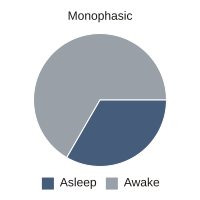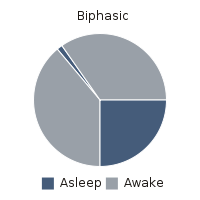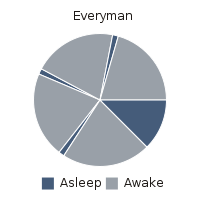多相睡眠
表示
多相睡眠(たそうすいみん、Polyphasic sleep、分割睡眠 Segmented sleep, divided sleep)は、一日に複数回の睡眠をとることである。人工照明発明以前の人類が行っていた、動物の一般的な睡眠法とされる[1]
2相睡眠(Biphasic sleep)
[編集]電気照明が発明される以前の中世、近世ヨーロッパでは、人々は夜寝始めの「第1睡眠」、夜中に目が覚めて朝まで寝る「第2睡眠」の2回の睡眠を取っていた[2][3]。
名称
[編集]中世英国、ロマンス語諸語、ナイジェリアティヴ族では、最初の眠りを「第1睡眠」、一度目が覚めてから2度目の眠りを「第2睡眠」と名付ける[9]。
- 英語:first sleep (dead sleep) 、second sleep (morning sleep)
- フランス語:premier sommeil (premier somme)
- イタリア語: primo sonno
- ラテン語: primo somno (comcubia nocte)
双方の睡眠の間の覚醒状態はフランス語では dorveille (睡眠と覚醒の間) と呼ばれる。
睡眠パターンの比較
[編集]| 名称 | 合計睡眠時間 | 方法 |
|---|---|---|
| 単相(Monophasic) | ≈8.0 h | 8 時間の主睡眠、4回のレム(REM)相 |
| 2相(Biphasic) | ≈6.3 h | 6 時間の主睡眠、3回のレム相 と、20分の仮眠1回、1回のレム。 |
| 通常 (昼寝 2回) | 5.2 h | 4.5 時間の主睡眠、2回のレム相 と、20分の仮眠2回、1回のレム。 |
| 通常 (昼寝 3回) | 4 h | 3 時間の主睡眠、1回のレム相 と、20分の仮眠3回、1回のレム。 |
| 通常 (昼寝 4-5回) | ≈3 h | 1.5 時間の主睡眠、1回のレム相 と、20分の仮眠4-5回、1回のレム。 |
| ダイマクション(Dymaxion)[11][12] | 2 h | 毎6時間(レム1回)に、30分の仮眠(計4回) |
| ウーベルマン(Uberman、ドイツ語:「超人」) | 2 h | 毎4時間(レム1回)に、20分の仮眠(計6回) |
関連項目
[編集]参照
[編集]- ^ Capellini, I.; Nunn, C.L.; McNamara, P.; Preston, B.T.; Barton, R.A. 2008. Energetic constraints, not predation, influence the evolution of sleep patterning in mammals. Functional Ecology 22:847–853.
- ^ http://www.historycooperative.org/journals/ahr/106.2/ah000343.html, Sleep We Have Lost: Pre-industrial Slumber in the British Isles, The American Historical Review
- ^ ジェッサ・ギャンブル 「自然な睡眠周期」の講演映像 - TEDカンファレンス、2010年9月、4分1秒。
- ^ Wehr, T.A. (June 1992). “In short photoperiods, human sleep is biphasic”. J Sleep Res 1 (2): 103–107. doi:10.1111/j.1365-2869.1992.tb00019.x. PMID 10607034.
- ^ Coturnix (16 October 2006). “What is a 'natural' sleep pattern?”. A Blog Around the Clock (ScienceBlogs) 2007年12月29日閲覧. "Includes image: the original data from Wehr's experiment."
- ^ A. Roger Ekirch (2005), At Day's Close: Night In Times Past, pp. 308-310 ISBN 0-393-05089-0
- ^ Frances Quarles (London 1644), Enchirdion ch. 54
- ^ A. Roger Ekirch (2005), At Day's Close: Night In Times Past, pp. 311-323 ISBN 0-393-05089-0
- ^ A. Roger Ekirch (2005), At Day's Close: Night In Times Past, pp. 301-302 ISBN 0-393-05089-0
- ^ Lejuwaan, Jordan. http://www.highexistence.com/alternate-sleep-cycles/
- ^ バックミンスター・フラー、6時間毎に30分の睡眠をとる生活を2年間継続 “Dymaxion Sleep”. Time Magazine. (1943-10-11) 2008年1月12日閲覧。.
- ^ "Dymaxion," polyphasicsleep.info Retrieved on 2009-07-25
- ^ Brown, Walter A., MD (2006-05-26). “Acknowledging Preindustrial Patterns of Sleep May Revolutionize Approach to Sleep Dysfunction”. Applied Neurology (CMPMedica) 2008年2月3日閲覧. "The discoveries of Ekirch and Wehr raise the possibility that segmented sleep is "normal" and, as such, these revelations hold significant implications for both understanding sleep and the treatment of insomnia."
- Warren, Jeff (2007). “The Watch”. The Head Trip: Adventures on the Wheel of Consciousness. Toronto: Random House Canada. ISBN 978-0679314080
- Jean Verdon, Night in the Middle Ages, trans. George Holoch (2002). ISBN 026803656X.
外部リンク
[編集]- Polyphasic Sleep: Facts and Myths – Dr. Piotr Wozniak – January 2005 – This article compares polyphasic sleep to regular monophasic sleep, biphasic sleep, as well as to the concept of free-running sleep.
- PolyphasicSleep.info – Informational wiki on intentional polyphasic sleep
- Miles to Go Before I Sleep at Outside.com, April 2005.
- Poly-phasers – an online polyphasic community with an active IRC channel, blogs, videos and articles
- TryPolyphasic.com – an active online polyphasic community, includes a map of world wide polyphasers
- Sleep We Have Lost: Pre-industrial Slumber in the British Isles
- Library of Congress Webcast - At Day's Close: Night In Times Past
- Slumber's Unexplored Landscape: People in traditional societies sleep in eye-opening ways
- New York Times, Richard A. Friedman, M.D., March 14, 2006, Wake Up and Smell the Savanna
- Coturnix, ScienceBlogs Includes image of original data, Wehr's experiment
- ジェッサ・ギャンブル 「自然な睡眠周期」の講演映像 - TEDカンファレンス、2010年9月、4分1秒。





